mobile View, to the German Version tap the flag


- Kingdom of Cambodia
- constitutional monarchy
- own name:
Preah Reach Ana Pak Kampuchea
- former name: Khmer
• Flags
• Historical Flags
• Meaning/Origin of the Flag
• Coat of Arms
• Meaning/Origin of the Coat of Arms
• Historical Coats of Arms
• Aircraft Roundel
• Map
• Numbers and Facts
• History
• Origin of the Country's Name
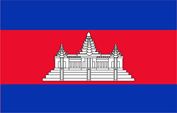
National flag,
ratio = 16:25, also 2:3,
Source, by:
Flags of the World





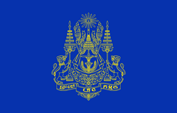
Flag of the King,
ratio = 16:25,
Source, by: Sodacan
This W3C-unspecified vector image was created with Inkscape.
[CC BY-SA 3.0], via Wikimedia Commons




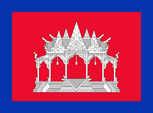
1893–1942,
National flag,
Source, by:
Flaggenbuch 1939



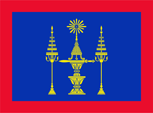
1893–1945(?),
Flag of the King,
Source, by:
Flaggenbuch 1939




1942–1945 (Japanese Occupation),
National flag,
ratio = 2:3,
Source, by:
Flags of the World



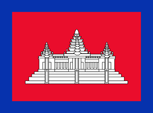
1945–1948,
National flag,
ratio = 2:3,
Source, by:
World Statesmen




1948–1970,
National flag,
Source, by:
Wikipedia (EN)



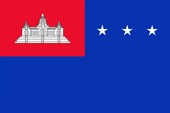
1970–1975,
National flag,
Source, by:
Wikipedia (EN)




1975–1976,
National flag,
Source, by:
Wikipedia (EN)



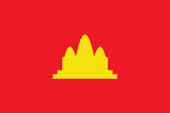
1975–1979,
National flag,
ratio = 2:3,
Source, by:
Wikipedia (EN)
→ click or tap here for more informations!



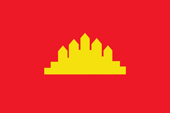
1979–1989,
National flag,
ratio = 2:3,
Source, by:
Wikipedia (EN)



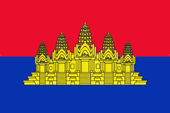
1989–1991,
National flag,
ratio = 2:3,
Source, by:
Wikipedia (EN)



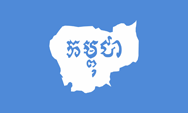
1991–1993,
National flag,
ratio = 3:5,
Source, by:
World Statesmen




The flag of Cambodia shows three horizontal stripes in the colours blue, red and blue, in the ratio 1:2:1, and carrys in the middle red stripe a depiction of the temple of Angkor Wat. The colours blue and red are already since long times in use in the flags of the land. For explanation of the colours there exist two different theories.
1.) Red stands for the blood, given in the struggle for freedom and independence, Blue stands for the wealth of the country
2.) Red is the national colour of the Khmer People, and should express willingness for sacrifices, blue is the coloor of the Khmer Royalty and represents the power and the wishes of the sovereign
The white temple symbolizes the glorious past of the land. White stands also for the confidence of the people in its sovereign. The flag exists in this design already until 1970 and was on 29th of june in 1993 adoped again per edict by prince Sihanouk. Under the socialistic governments between 1975 and 1989 there were in use red flags – symbolizing the communism – with an depiction of the temple of Ankor Wat in yellow. The colors of the flag of Cambodia are specified as follows, besides black and white: Blue = RGB RGB 3|46|161, which would correspond to Pantone 186, Red = RGB 224|0|37, which would correspond to Pantone 185, Yellow = RGB 252|221|9, which would correspond to Pantone Yellow C, Pale Blue = RGB 91|146|229, which would correspond to Pantone 279. The communist red is specified as RGB 218|18|26, which would correspond to Pantone 1788.
Source:
Wikipedia (EN)


since 1993,
Coat of arms of Cambodia,
Source:
Sodacan, Public domain, via Wikimedia Commons

The coat of arms of Cambodia is the heraldry of the Cambodian monarchy. It was adopted in a similar form already in 1953. It shows a light blue shield with an Unaome sign (Aum symbol), a sword, two ceremonial pedestal plates (Phan), a laurel wreath and the Royal Order of Cambodia, above which is placed the royal crown. The shield is held by the two royal animals, the Gajasingha (elephant-trunked lion) on the left and the Rajasingha (royal lion) on the right. Each lion holds two royal five-tiered umbrellas. The blue banner shows in Khmer the words: "Ruler of the Kingdom of Cambodia".
Source:
Wikipedia (EN)


1970–1975,
Coat of arms of the Khmer Republic,
Source:
Vektorisiert von FOX 52, CC BY-SA 4.0, via Wikimedia Commons

1975–1982,
Coat of arms of Democratic Kampuchea,
Source:
vectorized by Elena in General, Public domain, via Wikimedia Commons

1979–1981,
Coat of arms of the People's Republic of Kampuchea,
Source:
Ericmetro, Public domain, via Wikimedia Commons

1981–1989,
Coat of arms of the People's Republic of Kampuchea,
Source:
Vektorisiert von FOX 52, CC BY-SA 4.0, via Wikimedia Commons

1989–1992,
Coat of arms of the State of Cambodia,
Source:
Sarumo74, CC BY 3.0, via Wikimedia Commons

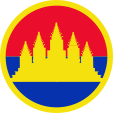
1989–1993,
Aircraft Roundel,
Source, by: Wikipedia (EN)
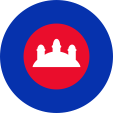
since 1993,
Aircraft Roundel,
Source, by: Wikipedia (EN)

Location:
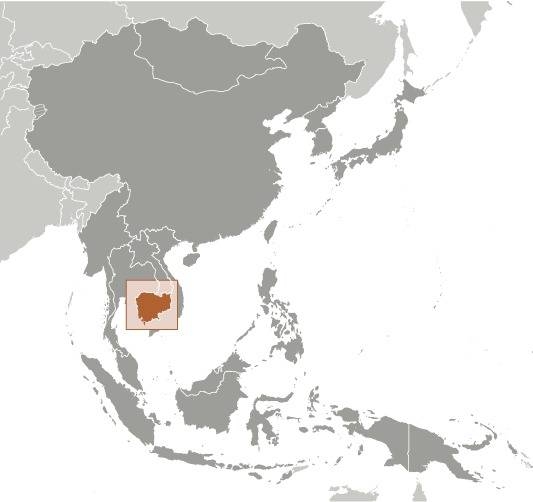
Source: CIA World Factbook
Map of the country:
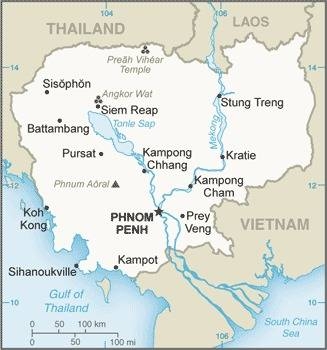
Source: CIA World Factbook

Area: 69.898 square miles
Inhabitants: 17.300.000 (2021), thereof 95% Khmer, 2% Cham, 2% Chinese, 0,2% Vietnamese
Religions: 97% Buddhist, 2% Muslim, 0,3% Christian
Density of Population: 248 inh./sq.mi.
Capital: Phnom Penh, 2.281.951 inh. (2019)
official Language: Khmer
other Languages: French, English
Currency: 1 Riel (KHR) = 100 Sen
Time Zone: GMT + 7 h
Source:
Wikipedia (EN)

200–600 · Empire of Funan
7th cent. · conquest by the Khmer, establishment of the Khmer Empire
802 · foundation of the Kingdom of Cambuia
13th cent. · invasions of the Thai, Shan and Mongolians
1353 · the Thai conquer the capital Angkor, momentary establishment of a Thai dynasty
1431 · transfer of the capital from Angkor to Phnom Penh
1623 · Vietnamese invasion
1660 · the King of the Khmer gets captured by the Thai, Cambodia comes in Siamese dependence
1863 · France makes a protection treaty with Cambodia, to protect it against an annexation by Siam (Thailand)
1867 · Siam recognizes the French protectorate over Cambodia
1884 · the French colonial administration takes over all sovereignty rights of the country
1887 · establishment of French Indochina, actually named Union of Indochina/Union Indochinoise (unification of all French territories: Tongking, Annam, Cochinchina, Laos and Cambodia
1893 · Laos gets annexed into French Indochina
1941 · Japanese troops occupy French Indochina, Cambodia has to cede areas in the north and west to Thailand (Siam)
August 1945 · proclamation of independence by Prince Sihanouk
October 1945 · invasion of French colonial troops
1946 · re-establishment of the French protectorate, beginning of the armed resistance against the colonial might (especially in Vietnam), until 1954 escalation to the Indochina War
1947 · France grants the status of a constitutional monarchy
1949 · France grants independence in framework of the French community
9th of November 1953 · the French colonial administration gets dissolved, day of independence
21st of July in 1954 · armistice negotiation at the Genf Indochina Conference, the First Indochina War ends, France withdraws its troops from whole Indochina, the independence of Cambodia is confirmed
1955 · Prince Sihanouk resigns as King, passes a new constitution and becomes premier of Cambodia, policy of strict neutrality
1960 · Prince Sihanouk takes over the function of Chief of State (State's President)
1969 · General Lon Nol becomes premier
1970 · General Lon Nol revolts against Prince Sihanouk and becomes Chief of State, rename of Cambodia in République Khmer, pro-US-American policy, intervention into the Vietnam War
1970–1975 · civil war in Cambodia, communist rebels under Pol Pot (Red Khmer) and followers of Prince Sihanouk struggle by support of North Vietnam against troops and followers of General Lon Nol
1972 · General Lon Nol becomes State's President
17th of April 1975 · defeat of Lon Nol's troops against the Red Khmer and the followers of Prince Sihanouk, General Lon Nol exiles in the USA, Prince Sihanouk becomes Chief of State
1976 · Prince Sihanouk gets unseated by the communist Red Khmer and comes under house arrest, rename of the République Khmer in Democratic Cambodia, the Red Khmer close the borders of the country and begin with "cleaning campaigns" of biger dimensions and begin a re-education program for the whole nation, until 1978 dies in this way a quarter of the population of the country
1977 · frontier conflicts with Vietnam
1978 · Vietnam intervenes in Cambodia and terminates on the 7th of January 1979 the reign of the Red Khmer, seize of power by the from Vietnam dependent Heng Samrin, Prince Sihanouk exiles
10th of January 1979 · proclamation of the People's Republic of Cambodia
1979–1990 · civil war in Cambodia, Red Khmer, royalists and bourgeois groups struggle against the Vietnamese occupation troops and the Chief of State Heng Samrin
1982 · Prince Sihanouk forms an exile government under inclusion of all resistance groups
1985 · Pol Pot resigns as commander of the Red Khmer
1988 · negotiations of the exile government with the government of Heng Samrin
1989 · withdrawal of the Vietnamese troops
1990 · establishment of the supreme national counsel, as a mutual government of all conflict camps (Red Khmer, royalists, bourgeois, followers of Heng Samrin)
1991 · Paris Peace Treaty
1993 · elections of a parliament (boycotted by the Red Khmer), victory of the FUNCINPEC-Party of Prince Ranariddh (son of Prince Sihanouk), defeat of the People's Party of Hun Sen, new constitution, Cambodia becomes kingdom, Prince Sihanouk becomes King, Prince Ranariddh becomes prime minister
1994 · the Red Khmer begin the struggle again
1997 · armed resistance against Prince Ranariddh, Hun Sen seizes the power
15th of April 1998 · death of Pol Pot
26th of July 1998 · parliament's elections, victory of Hun Sen's People's Party, the FUNCINPEC-Party of Prince Ranariddh coallies with the People's Party, Hun Sen becomes premier, Prince Ranariddh becomes President of the Parliament, re-integration of the Red Khmer into the public live and into the army
1999 · the last leader of the Red Khmer is captured
2004 · King Sihanouk abdicates, his son Norodom Sihamoni becomes king
Source:
Atlas zur Geschichte,
World Statesmen,
Wikipedia (D)

The name of Cambodia goes back to the Kambuja Empire, a founding of the Khmer nation, which existed here from the 9th to the 15th century. The empire then became dependent on its neighbors. Nevertheless, the name was retained, namely as "Kampuchea", known to the west as "Cambodia". Only briefly, between 1970 and 1975, the country was called "Republic of Khmer". Today the practice seems to have prevailed of calling the country "Kampuchea" as a socialist country and "Cambodia" for the bourgeois-monarchist state, strangely, it's one and the same word.
Source:
Wikipedia (D)

Kindly supported by: Siegfried Ehrmann

![]()


















































